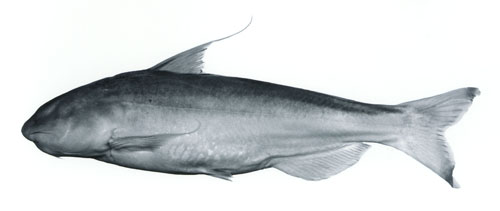
Photo by Britt Griswold
Reproduced from Vari, Ferraris and de Pinna (2005).
Cetopsis Spix & Agassiz, 1829
The combination of the absence of a spinelet associated with the dorsal fin, the absence of spines on the dorsal and pectoral fins, and the possession of a single row of teeth on the vomer distinguishes Cetopsisfrom the other genera in the Cetopsinae.
KEY TO THE SPECIES OF CETOPSIS
| 1. | Species found only west of the Andes, including the Maracaibo Lake basin | 2 |
| Species found east of the Andes Mountains | 7 | |
| 2. | Distal margins of pectoral and anal fins with distinct, dark pigmentation | Cetopsis fimbriata |
| Distal margins of pectoral and anal fins lacking dark pigmentation | 3 | |
| 3. | Caudal fin darkly pigmented throughout other than for narrow, pale, distal margin | Cetopsis motatanensis |
| Caudal fin not darkly pigmented | 4 | |
| 4. | Mouth moderate, its width much less than one-half of HL and approximately equal to distance from tip of snout to posterior margin of orbit | Cetopsis othonops |
| Mouth wide, its width equal to approximately one-half of HL | 5 | |
| 5. | Branched anal-fin rays 20 to 22 | Cetopsis baudoensis |
| Branched anal-fin rays 23 or more | 8 | |
| 6. | Anal-fin origin located approximately at vertical through middle of SL and distinctly anterior of middle of TL; 8, rarely 9, pectoral-fin rays; 29 to 33 total anal-fin rays | Cetopsis amphiloxa |
| Anal-fin origin located distinctly posterior of vertical through middle of SL and approximately at middle of TL; 9 pectoral-fin rays; 28 total anal-fin rays | Cetopsis jurubidae | |
| 7. | Eyes absent; filaments on fist rays of dorsal and pectoral fins extremely elongate; first dorsal-fin ray longer than 0.50 of SL; first pectoral-fin ray extending posteriorly to beyond vertical through middle of base of anal fin; body length less than 36 mm SL | Cetopsis oliveirai |
| Eyes present and always obvious to some degree; filaments on first rays of dorsal and pectoral absent or only moderately-developed; body length of adults distinctly greater than 36 mm SL | 8 | |
| 8. | Posterior nares in form of transverse slit; medial margins of contralateral nares separated by distance distinctly less than one-half of distance between contralateral anterior nares | Cetopsis coecutiens |
| Posterior nares rounded; medial margins of contralateral nares separated by distance slightly less than distance between contralateral anterior nares | 9 | |
| 9. | Teeth on dentary, premaxilla, and vomer incisiform and in arranged in single rows | Cetopsis candiru |
| Teeth on dentary, premaxilla, and vomer conical with multiple tooth rows on premaxilla and usually with multiple tooth rows on dentary | 10 | |
| 10. | Base of caudal fin with posteriorly-rounded, variably-developed, bilobed patch of dark pigmentation | 11 |
| Base of caudal fin without posteriorly-rounded, variably-developed, bilobed patch of dark pigmentation | 16 | |
| 11. | Dark pigmentation on sides of body only in form of very small, spots | Cetopsis pearsoni |
| Dark pigmentation on sides of body with eye-size, or larger, dark spots | 12 | |
| 12. | Dark pigmentation on sides of body limited to eye-size spots | Cetopsis montana |
| Dark pigmentation on sides of body consisting of both eye-size, or larger, spots and very small spots | 13 | |
| 13. | Caudal fin dusky overall with numerous, dark chromatophores extending nearly to posterior margin of fin; dorsal fin with distinct spot of dark pigmentation basally; dorsal fin with dark pigmentation present on first interradial membrane | 14 |
| Caudal fin pale other than for dark basal pigmentation, with few scattered, dark chromatophores posterior of dark bilobed basal spot; dorsal fin pale or if dark pigmentation present then not forming distinct basal spot; dorsal fin without dark pigmentation on first interradial membrane | 15 | |
| 14. | Distinct demarcation present between dark pigmentation on dorsal and dorsolateral surfaces of body versus more ventral regions; dark spots of eye-size or larger limited to portion of lateral surface of body dorsal of horizontal through ventral margin of caudal peduncle | Cetopsis arcana |
| No distinct demarcation present between dark pigmentation on dorsal and dorsolateral surfaces of body versus more ventral regions; dark spots of eye-size or larger dark present on ventrolateral surfaces of body below horizontal through ventral margin of caudal peduncle | Cetopsis sandrae | |
| 15. | Dark pigmentation on body extending onto base of anal-fin rays; 21 branched anal-fin rays | Cetopsis umbrosa |
| Dark pigmentation on body not extending onto base of anal-fin rays; 22 or 23 branched anal-fin rays | Cetopsis starnesi | |
| 16. | Dark humeral spot present | 17 |
| Dark humeral spot absent | 20 | |
| 17. | Pectoral fin darkly pigmented except along distal margin | Cetopsis parma |
| Pectoral fin pale | 18 | |
| 18. | Body with eye-size or larger, dark spots at least on dorsal surface; caudal fin with dark pigmentation extending nearly to distal margin | Cetopsis orinoco |
| Body lacking eye-size or larger, dark spots at least on dorsal surface; caudal fin lacking dark pigmentation on rays | 19 | |
| 19. | Pectoral-fin rays 8; branched anal-fin rays 18 | Cetopsis caiapo |
| Pectoral-fin rays 9; branched anal-fin rays 21 | Cetopsis sarcodes | |
| 20. | Anterior and lateral surfaces of snout without dark pigmentation; dorsal fin with dark semicircular spot basally and remainder of fin pale | Cetopsis gobioides |
| Anterior and lateral surfaces of snout with dark pigmentation; dorsal fin with extensive distribution of dark pigmentation across fin; first dorsal-fin ray darkly pigmented | Cetopsis plumbea |